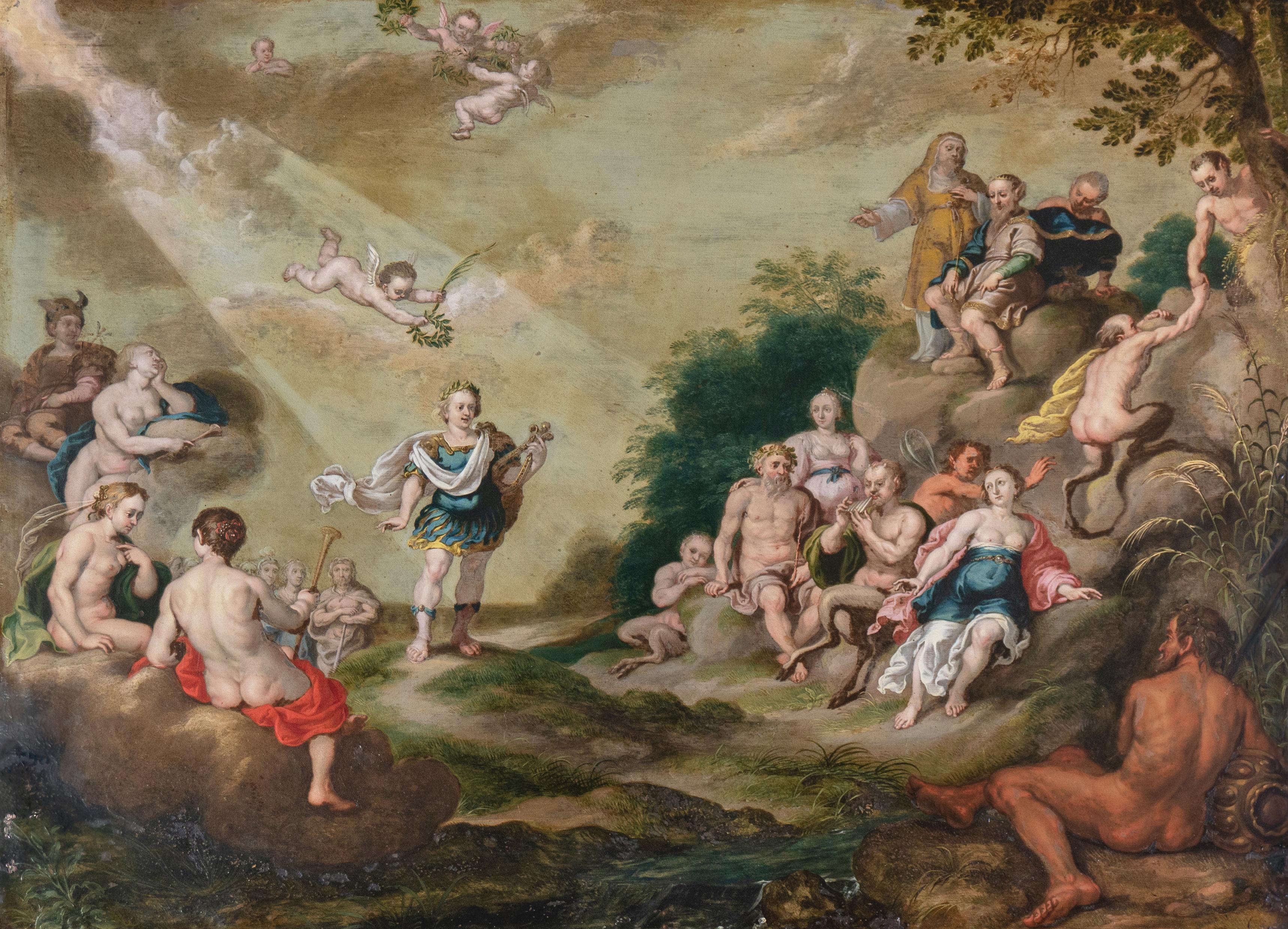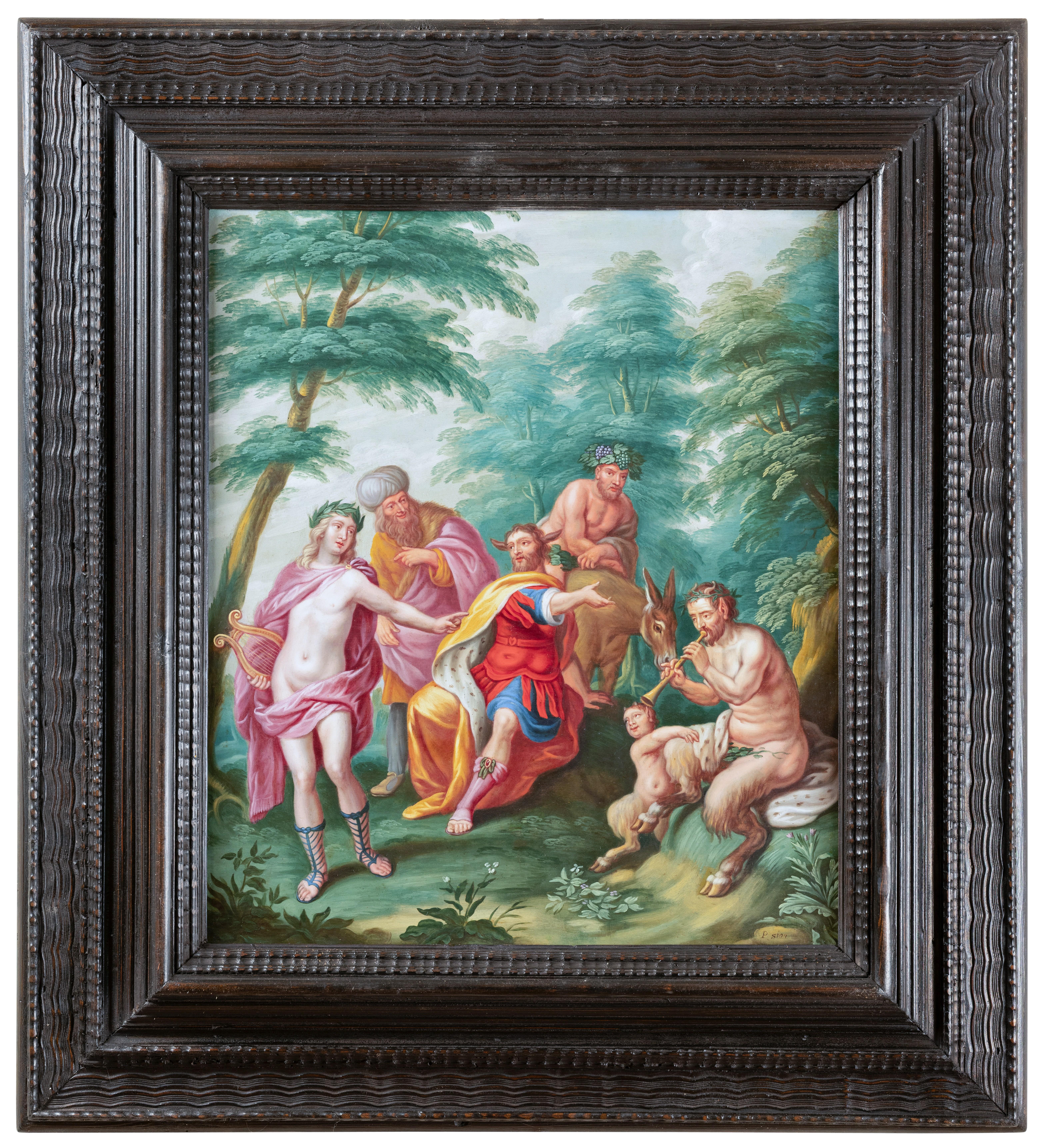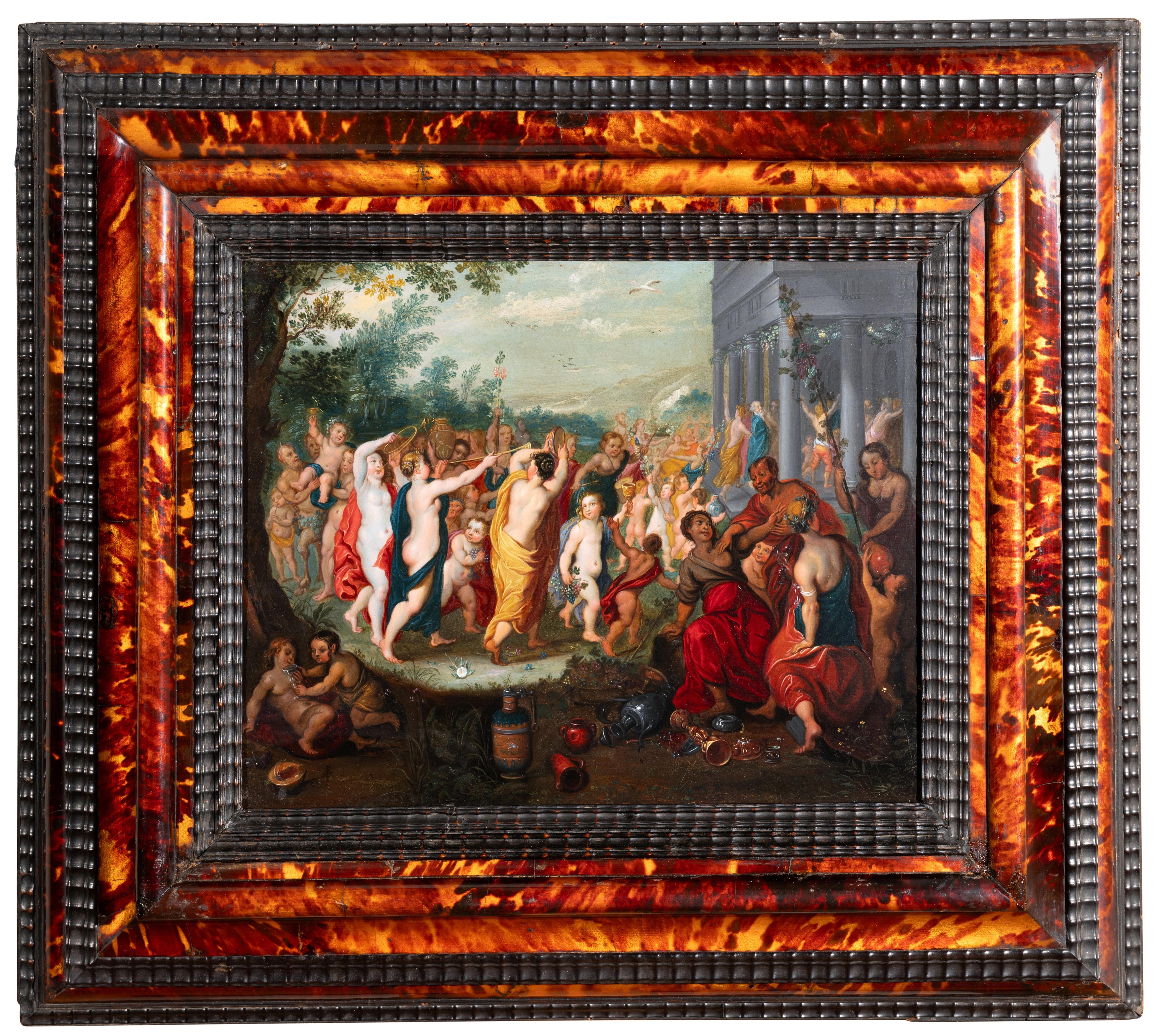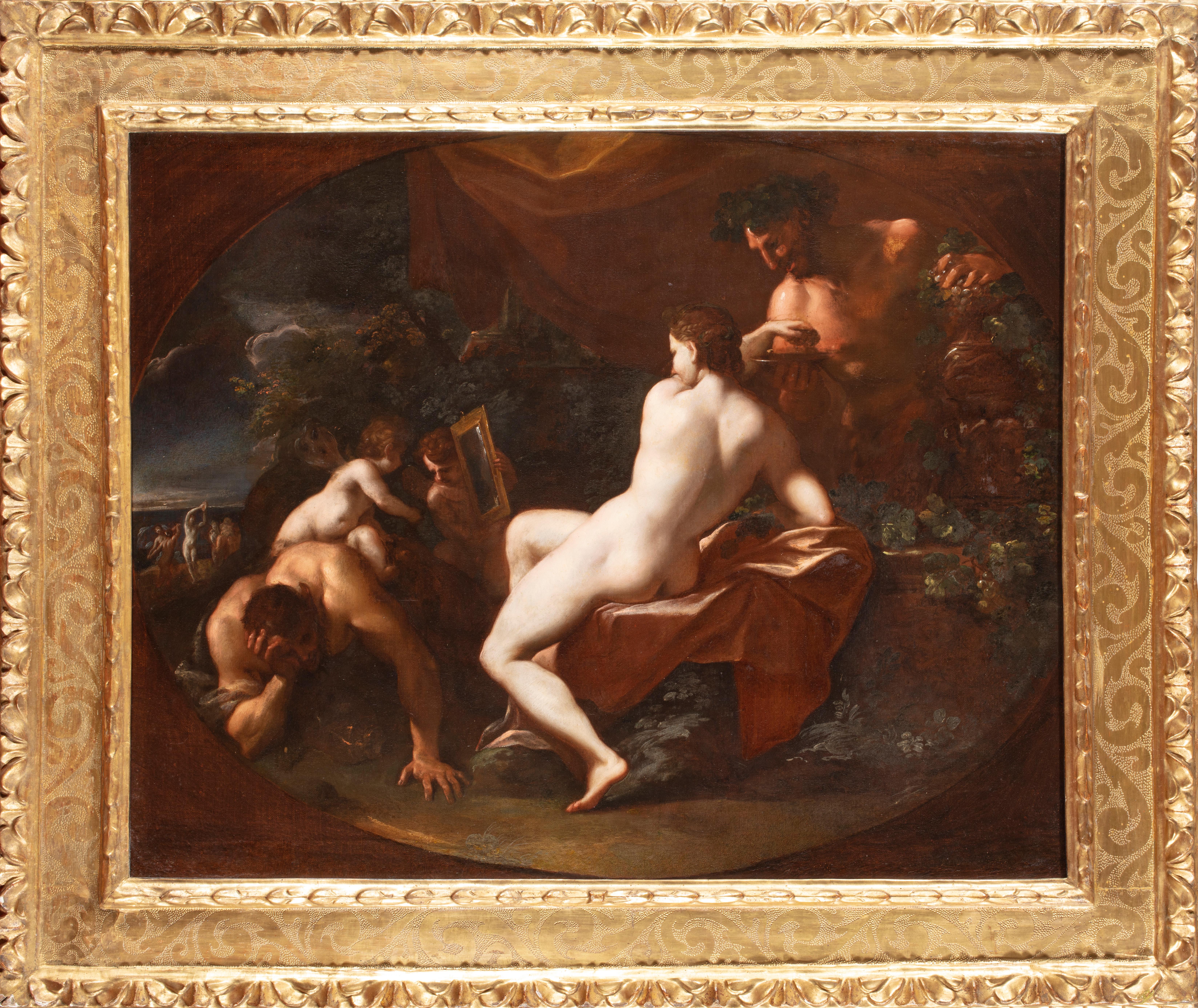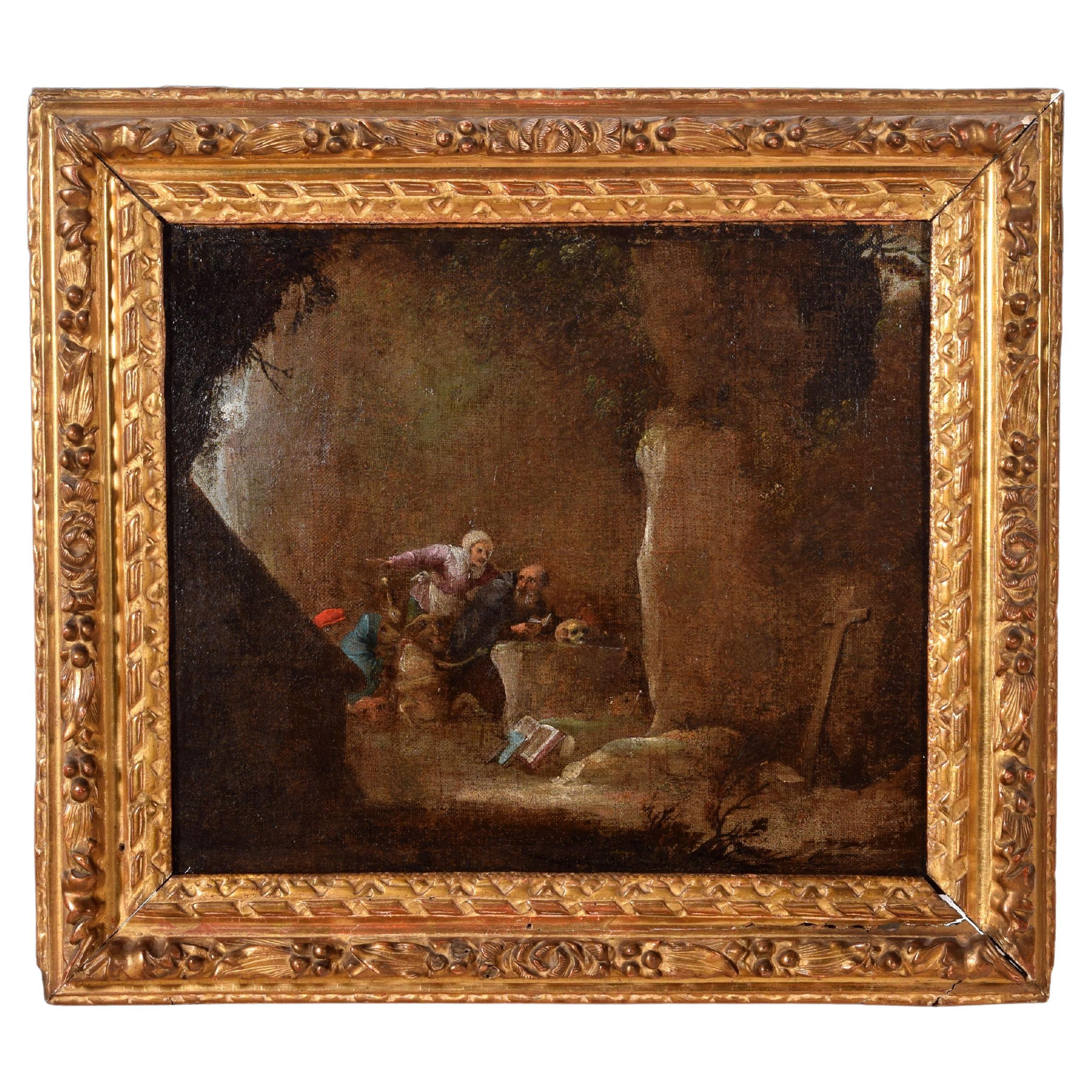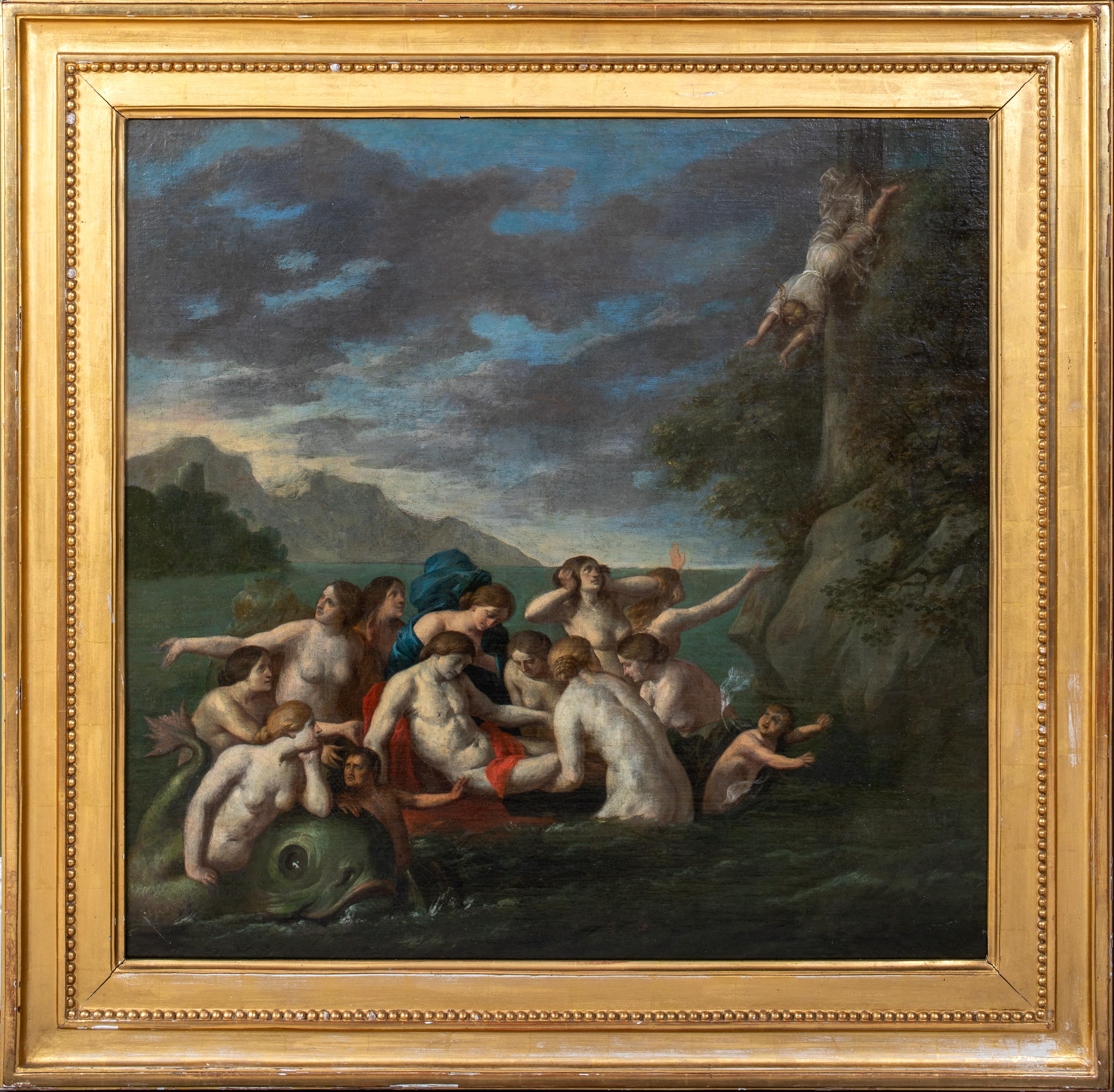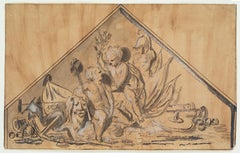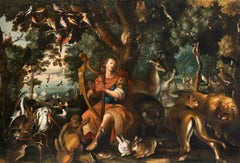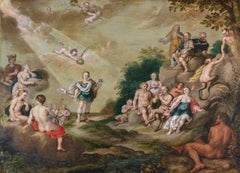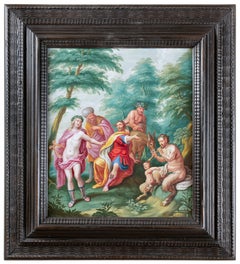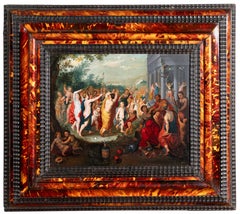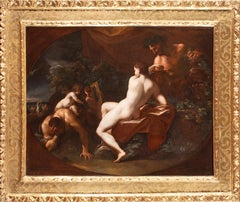Items Similar to Thomas Willeboirts Bosschaert, Dancing Putti, Pan, Satyr, Rubens School, Model
Video Loading
Want more images or videos?
Request additional images or videos from the seller
1 of 19
Thomas Willeboirts BosschaertThomas Willeboirts Bosschaert, Dancing Putti, Pan, Satyr, Rubens School, Modelc. 1640
c. 1640
$17,328.19
$21,660.2420% Off
£12,828.98
£16,036.2220% Off
€14,400
€18,00020% Off
CA$23,992.10
CA$29,990.1220% Off
A$26,193.63
A$32,742.0320% Off
CHF 13,732.25
CHF 17,165.3120% Off
MX$318,131.67
MX$397,664.5920% Off
NOK 171,493.40
NOK 214,366.7520% Off
SEK 161,935.50
SEK 202,419.3720% Off
DKK 109,630.28
DKK 137,037.8520% Off
About the Item
Thomas Willeboirts Bosschaert
Pan plays to the dance of the putti
Thomas Willeboirts Bosschaert (1614 Bergen op Zoom - 1654 Antwerp)
Pan plays to the dance of the putti
Oil sketch
Oil on canvas, 35 x 51 cm
Provenance:
Belgian private collection, ca. 1980 to 2020.
The oil sketch shows a flute-playing man with dark curls sitting at the left edge
of the picture in a recess draped with cloth. In the lower left corner, a fallen
bowl with leaking water can be seen. The right half of the picture shows a circle
of five dancing putti, whereby the left putti can be recognized as a satyr due to
the goat legs. The background is dominated by a dark mountain landscape. In
the sky a rising or setting sun can be guessed. It is possible that the flute player
represents Bacchus, the god of wine and ecstasy. This fits with the flute as a
symbol of celebration, as well as the bowl of water, which could refer to
Bacchus' mother, Lethe. Lethe is a river in the underworld, which at the same
time symbolizes "oblivion". Thus, the spilling water bowl is not only a reference
to this river, but it also symbolizes "oblivion". Moreover, Bacchus is usually
depicted with satyrs in his retinue, which would explain the putto with goat legs.
However, the interpretation of the flute player as the god Pan would be
possible. He is usually shown with his flute and associated with dance.
Moreover, he is native to the mountainous landscape of Arcadia.
The present work is an oil sketch, i.e. a preparatory study. This is suggested by
the partly unfinished parts, as well as the structure of the picture. Some parts
are already almost completely laid out, such as the flute player, while others, for
example the horizon and also the figures of the putti, are only sketched in
outline.
The painting can be attributed to the Baroque painter Thomas Willeboirts
Bosschaert. This attribution was also confirmed by Prof. Hans Vlieghe.
Bosschaert lived and worked in Antwerp with Peter Paul Rubens and Anthonis
van Dyck, among others. He studied with Gerard Seghers and probably also with
Van Dyck. In 1637 he joined the St. Luke's Guild. His work is characterized by a
large number of religious and historical paintings. He worked for Prince
Frederick Henry of Orange and Prince William II of Orange, among others.
The present oil sketch is a smaller version of the "Children's Bacchanal" by
Bosschaert in Kassel. This painting shows a multitude of putti surrounding and
celebrating with the drunken boy Bacchus. The basic compositional structure, as
well as the design of the putti, shows a great closeness to the oil sketch. The
"Cupid with tamed lion (Amor Triumphans)" also shows great similarities in
structure and style. In Bosschaert's oil sketch "Venus Holds Back Mars -
Allegory of War" we find, among other things, the standing putto, facing the
viewer.
The present oil sketch will have served as a preparatory study for a larger history
painting. This working practice is often attested for collaborators or the circle of
Peter Paul Rubens and Anthonis Van Dyck.
Thomas Willeboirts Bosschaert was particularly influenced by Van Dyck. This is
also evident in this work, as comparable putti are depicted in Van Dyck's
"Triumph of Bacchus", for example. The concentration of the figures on the
right side of the picture, a similarly yellowish sky and various pictorial elements
such as the fallen bowl (albeit filled with fruit) are also found there. Van Dyck's
"Rest on the Flight into Egypt" is also very similar in pictorial composition. On
the right side we see the dancing putti in a circle. On the left side, however,
instead of the flute player, there is the Holy Family.
A model or inspiration for the present work could have been an engraving by
the Italian Giulio Carpioni (1613-1678). The composition (though mirrored due
to the copper engraving) is very similar, showing dancing putti on the left and a
flute player with buck legs and curls on the right. In addition, one of the putti is
also marked as a satyr with goat legs.
The present oil sketch from the hand of Bosschaert is an interesting addition to
his oeuvre and illustrates not only his creative style but also his stylistic
proximity to Van Dyck.
Literature:
Axel Heinrich, Thomas Willeboirt's Bosschaert, Turnhout 2003, vol. I, cat A 58,
fig. 88.
- Creator:Thomas Willeboirts Bosschaert (1614 - 1654, Flemish, Dutch)
- Creation Year:c. 1640
- Dimensions:Height: 13.78 in (35 cm)Width: 20.08 in (51 cm)
- Medium:
- Movement & Style:
- Period:
- Condition:
- Gallery Location:Greven, DE
- Reference Number:1stDibs: LU155028411832
About the Seller
4.8
Platinum Seller
Premium sellers with a 4.7+ rating and 24-hour response times
Established in 2011
1stDibs seller since 2021
30 sales on 1stDibs
Typical response time: 1 hour
- ShippingRetrieving quote...Shipping from: Greven, Germany
- Return Policy
Authenticity Guarantee
In the unlikely event there’s an issue with an item’s authenticity, contact us within 1 year for a full refund. DetailsMoney-Back Guarantee
If your item is not as described, is damaged in transit, or does not arrive, contact us within 7 days for a full refund. Details24-Hour Cancellation
You have a 24-hour grace period in which to reconsider your purchase, with no questions asked.Vetted Professional Sellers
Our world-class sellers must adhere to strict standards for service and quality, maintaining the integrity of our listings.Price-Match Guarantee
If you find that a seller listed the same item for a lower price elsewhere, we’ll match it.Trusted Global Delivery
Our best-in-class carrier network provides specialized shipping options worldwide, including custom delivery.More From This Seller
View AllPutti in a Landscape, Putti playing, flowers, Berchet, French Art, Old Master
By Pierre Berchet
Located in Greven, DE
Pierre Berchet, Drawing of Putti playing in a landscape,
Painter of decorative history subjects; trained under La Fosse; worked in France and during the 1690s...
Category
17th Century Baroque Figurative Drawings and Watercolors
Materials
Handmade Paper
$1,732 Sale Price
20% Off
Old Master Drawing, Baroque, Jacob de Wit, Allegory of Victory, Putti, Ships
By Jacob De Wit
Located in Greven, DE
Two putti with symbols of war and victory (cannons, cannonballs, armour, anchor, lion's head, laurel branch/ olive branch, flag, staff with helmet) in pediment triangle.
Probably a design for a painting or architecture
Pen-and-ink drawing in black on brownish paper, black wash
Plain gold moulding with UV glass
Allegory of Victory, 18th Century, Old Master Drawing, By De Wit, Figurative
Jacob de Wit...
Category
Late 17th Century Baroque Figurative Drawings and Watercolors
Materials
Paper, Crayon
$2,190 Sale Price
35% Off
Flemish 17th, Orpheus and Animals, Large Decorative Wall Old Master Painting
Located in Greven, DE
Flemish school, 17th century
Orpheus and the animals
Oil on canvas, 146,5 x 217 cm
Provenance: South German private collection.
On an impressive, room-filling format, this painting depicts "Orpheus and the Animals."
The harp-playing Orpheus sits centrally in front of a tree whose trunk bifurcates above his head. This central tree frames with its crown the scenery towards the horizon and at the same time offers through branches the possibility for many birds to find space. The left half of the picture is characterized by a seascape, at the edge of which the ruins of a castle can be seen deep in the background. This seascape, framed by mountains on the horizon, is the only area where sky can be seen. On this side, waterfowl such as storks, swans and ducks can be seen. In the right half, the viewer looks into a deep European forest. On this right side, more land animals can be found, such as deer, rabbits and lions, among others. Orpheus wears opulent red and gold trimmed clothing, under his blue breastplate we see a white shirt. His feet are adorned by elaborate sandals. His head is surrounded by a radiant laurel wreath ("poeta laureatus"). The young man is clearly identifiable as the singer and poet of Greek mythology, Orpheus, by his harp, the laurel wreath and the animals surrounding him.
Orpheus was one of the Argonauts who, under Jason, was searching for the Golden Fleece. He sang so beautifully that he even conquered the angry sea and enemies by the magic of his lyre. During the journey, Orpheus is said to have drowned out even the sirens with his singing. It is said that he was the greatest of all poets and charmed people, animals, stones and trees with his singing.
In total, 51 birds and 37 different species are depicted in the painting. The animals are mostly depicted in great detail and, except for a few, can be identified. Mainly European species of animals are shown. Exceptions are the ostrich-like nandu peeking out from behind the deer, as well as the large parrot on the upper left, and the two lions. Similar is the case for the large animal directly behind Orpheus on the right. The shape of the head suggests an arctic fox from the polar regions, even though the body is much too large. The arctic fox was first described in 1555 by Olaus Magnus. However, it could also be a depiction of a brown or black bear.
An unusual detail is the animal, which is relatively isolated in the right background and looks to the left. It is not clearly identifiable, but it shows certain similarities with the Australian kangaroo. This was first described by Vespucci in 1500 and further by Francisco Pelsaert in 1629. If it is indeed a kangaroo, this would be one of the earliest surviving pictorial representations.
In this painting, Orpheus is accompanied by a small monkey playing a viola da gamba. This is an iconographic peculiarity. In general, this painting has some peculiarities compared to other paintings with "Orpheus and the animals". The central positioning of Orpheus is quite common, but he usually holds a lyre and is dressed in an antique style, but not as opulently. The choice of animals is also remarkable: European animals in particular are seen, hardly any exotic features, such as camels or elephants.
The two lions in the right foreground are a quotation from Peter Paul Rubens and his depiction of "Daniel in the Lion's Den", which was realized in an engraving.
The present painting can be classified as belonging to the Flemish School of the 17th century on the basis of its painterly and compositional conception. From the circle of Jan Brueghel the Younger are numerous representations of this Orpheus - theme, which take it as an opportunity to show as many exotic animals. There are also echoes of Spanish painters such as Juan de Arellano...
Category
17th Century Baroque Landscape Paintings
Materials
Canvas, Oil
Hercules and Omphale, Old Master Painting, Mannerism, Baroque, Mythology, Prague
Located in Greven, DE
Hercules and Omphale
Oil on panel, 52 x 41 cm
According to legend, Hercules had to make atonement and became a slave to the Lydian queen Omphale. When she found out who her slave was, she married him. Falling for his mistress and made effeminate by the luxury of court life, the former hero allowed himself to become the laughing stock of the court. He dressed in women's clothes, spun wool and did other women's work, whereas Omphale wore his lion's skin and carried a wooden club. When the time of punishment was over, the hero realised his delusion and left Omphale.
So far, the painting could not be clearly assigned to an artist. Nevertheless, it impresses with its fluid and convincing painting, whose colourfulness and conception are reminiscent of the Prague School around Bartholomäus Spranger.
This work follows an engraving and an etching made by Michel Dorigny in 1643 after a design by Simon Vouet. It shows the same scene but the print differs in minor details from the present painting (see e.g. the head of the lion) and the treatment of the faces seems to be painted more detailed and refined.
So far there is no painting...
Category
17th Century Baroque Figurative Paintings
Materials
Oil, Panel
Road to Emmaus in a Landscape, Pilgrims, Gillis de Hondecoeter, Old Master
Located in Greven, DE
The painting "The Road to Emmaus in a Landscape" by Gillis de Hondecoeter is a masterful example of early 17th-century Dutch landscape painting. The sce...
Category
17th Century Baroque Figurative Paintings
Materials
Oil, Canvas
$14,079 Sale Price
35% Off
Claude Lorrain Landscape with temptation of Saint Anthony, Aquatint by Earlom
By (after) Claude Lorrain (Claude Gellée)
Located in Greven, DE
Claude Lorrain landscape with the temptation of Saint Anthony .Richard Earlom aquatint c1817
by Lorrain, Claude le/Earlom, Richard
Country...
Category
19th Century Baroque Landscape Prints
Materials
Paper
You May Also Like
'The Music Contest between Apollo and Pan', Renaissance Mythology, Satyr, Hermes
By Flemish School, 17th Century
Located in Santa Cruz, CA
An early 17th-century Flemish School oil on copper showing the mythological contest between Apollo and Pan in which the mountain god, Tmolus, gives judgement for Apollo. Unsigned. Pa...
Category
Early 17th Century Northern Renaissance Figurative Paintings
Materials
Copper
The Musical Contest between Apollo and Marsyas, signed P. Sion, Antwerp 17th c.
Located in PARIS, FR
The Musical Contest between Apollo and Marsyas,
by Peter Sion (Antwerp, 1624-1695)
Signed in the lower right corner P. Sion
17th century Antwerp School
Oil on copper, dim. h. 53 cm, ...
Category
17th Century Old Masters Figurative Paintings
Materials
Oak, Oil, Wood Panel
The Triumph of the Infant Bacchus, workshop of H. Van Balen, 16th c. Antwerp
By Hendrick van Balen
Located in PARIS, FR
The Triumph of the Infant Bacchus,
Workshop of Hendrick Van Balen (1575-1632)
Antwerp, c.1630
Oil on copper, h. 28 cm (11.02 in), w. 35 cm (13.78 in)
A large Roman 17th century golden painted frame
Framed: h. 52 cm (20.47 in.), w. 58 cm (22.83 in)
Our finely painted work depicts The Triumph of the Bacchus as a young boy and is one of the most popular mythological subjects in Antwerp at the beginning of the 17th century. Feasting, wine and fun are the themes that constantly appeal to the public.
Thus unfolds before our eyes on our painting the procession composed of nymphs, baccantes, fauns, satyrs and children, their bodies naked, partially covered with brightly coloured draperies that help to brighten up the parade. Playing various instruments, dancing and drinking, while carrying vases and poles adorned with grapevines, participants to the rhythm of a noisy brass band make their way to an ancient temple standing on the right. The exaggerated gestures convey to us the frenzy of the excited crowd.
The Child Bacchus follows the joyous procession, carried by satyrs and nymphs, crowned with ivy and joyfully raising a cup of wine. In the foreground, the drunken participants leave the procession, the children on the left and the group of bacchantes and satyrs on the right are resting among various objects scattered at their feet: cups, vases, ewers bear witness to the festivities in progress.
In the background, a hilly landscape stretches out on the horizon, a semblance of calm that contrasts with the bustle of the foreground.
The artist strives to multiply the many details, whether it be figures, costumes, flowers or vegetation, in order to demonstrate his know-how and the perfection of his execution.
The acidulous palette with fresh and varied colours is characteristic of Hendrick Van Balen's works.
There are several versions identical to ours with similar dimensions painted by Hendrick Van Balen and his workshop.
Related works:
• Koller Auction, Zurich, 21/09/2007, oil on copper, 28,5 x 37,4 cm.
• Staatliche Kunsthalle, Karlsruhe, Inv. N° 809 (oil on copper, 40 x 53,5 cm)
• Auktionshaus für Altertümer Glückselig, Vienne, 10/05/1932, ( oil on copper, 34 x 42 cm)
• Gemäldegalerie of Pommersfelden, Schloss Weissenstein, oil on panel, 47 x 64 cm
Hendrick Van Balen, Flemish painter, born and died in Antwerp (1575-1632). A pupil of Adam Van Noort, he entered the Guild of St. Luke in 1593, later trained in Italy and was Van Dyck's first teacher. He often painted small figures taken from scenes from the Bible or classical mythology, on paintings whose backgrounds and landscapes were painted by Josse de Momper...
Category
17th Century Old Masters Figurative Paintings
Materials
Copper
17th Century By Domenico Maria Canuti Toilet of Venus with Cupids and Satyrs
Located in Milano, Lombardia
Domenico Maria Canuti (Bologna 1626 - 1684)
Title: Toilet of Venus with Cupids and Satyrs
Medium: Oil on canvas
Dimensions: without frame 79 x 98 cm - ...
Category
Late 17th Century Old Masters Figurative Paintings
Materials
Cotton Canvas, Canvas, Oil
The temptation of St Anthony. Oil on canvas. 17th c., after David Teniers II
By David Teniers the Younger
Located in Madrid, ES
Temptations of San Antonio Abad. Oil on canvas. 17th century, following the model of David Teniers II (Antwerp, 1610-Brussels, 1690).
Oil on canvas showing a figurative scene located inside a cave. To the right, you can see a cross standing, supported; to the left, a hut; and in the center of the painting appears an elderly, bearded man, leaning on a table on which there is a ceramic jug and a skull, with an open book at the foot of it. The man looks towards a woman, who points to something outside, and appears accompanied by a large frog and a series of ghostly beings or monsters dressed in brightly colored cloth and clothing.
San Antonio Abad or Antonio Magno (251-356) was a Christian monk, considered the founder of the eremitical movement. He was tempted numerous times by the devil while he was in the desert, becoming a subject frequently represented in art (as can be seen in this oil painting). He is represented in a black habit because the Order of the Knights of the Hospital of San Antonio (Hospitals) was placed under his patronage, being the color of the habits of the members of this order (the tau or Egyptian cross was also the symbol chosen by they).
David Teniers II or El Joven was a prominent Flemish painter and engraver, son of David Teniers El Viejo or I and father of David Teniers III, much appreciated at the time for his scenes of villagers and common people, his paintings of monkey painters, etc. . He dealt with the theme of the Temptations of Saint Anthony...
Category
Antique 17th Century European Baroque Paintings
Materials
Other
Hero And Leander, 17th Century Studio of DAVID II TENIERS (1610-1690)
By David Teniers the Younger
Located in Blackwater, GB
Hero And Leander, 17th Century
Studio of DAVID II TENIERS (1610-1690)
Large 17th century Dutch Old Master classical scene of Hero and Leander, oil on canvas. Excellent quality an...
Category
17th Century Figurative Paintings
Materials
Canvas, Oil
